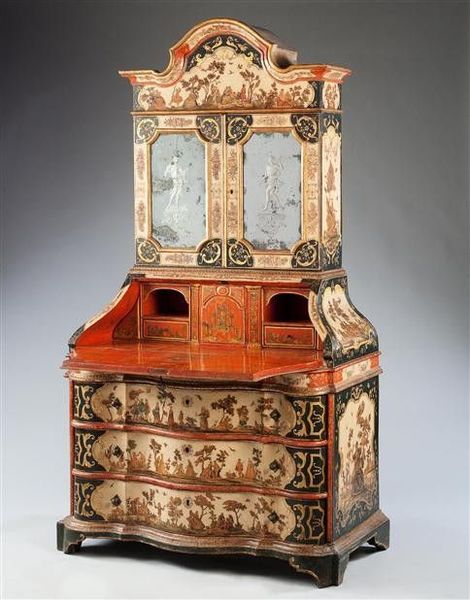An important early 18th century Venetian arte povera bureau bookcase. Italy, ca 1740
An important early 18th century Venetian arte povera bureau bookcase. Italy, ca 1740 © 2012 MALLETT ANTIQUES
profusely decorated with elaborate decoupages vignettes on every surface on a cream ground. Each panel is enclosed by running floral and foliate designs. The slope front has fantasy carriages drawn by various horses and surrounded by various beasts. Opening to reveal a fitted interior with pigeon holes, small drawers and fully decorated writing surface. The three lower drawers are decorated with figures in period dress and romanticised pastoral landscapes. The whole surface is in extraordinary original condition. The decoupage retains good colour and engraved detail. The antique mirror plates engraved with dancing figures.
Since as far back as the late 16th century, lacquered objects from the Far East had been shipped to Europe, in relatively small numbers at first, though subsequently in constantly increasing quantities to meet the burgeoning demand. The relative scarcity of lacquered objects combined with the immense demand meant they commanded high prices, a fact that drove European craftsmen to discover the process for themselves or at least a method of imitating it convincingly.
Lacquer centres thus appeared throughout Europe, with Venice becoming one of the most significant of all. As early as the mid 17th century there existed an extremely active trade in Venetian lacquer, which suggests that it had been going on for some time previously. As with all lacquer centres during the period, Venice had its own recipes for the necessary varnish, but it seems the favoured type was that invented by Father Coronelli (1659-1702), the official cosmographer of the Serenissima, who made globes that he protected with layers of varnish. Coronelli stated that its main ingredient was sandarac, known for its durability and hardness, and this remained one of the chief ingredients of Venetian lacquer. Initially, again like elsewhere in Europe, Venetian artisans would imitate Oriental styles and models in an attempt to give their work the exotic appearance that was favoured at the time. However, as the 18th century progressed, Venetian lacquered objects would become less dependent stylistically on imported Far Eastern models and follow more closely the general trend of contemporary European fashion.
Arte Povera (also lacca povera or lacca contrafatta), particularly in Venice, developed along-side traditional lacquer as what is initially regarded to have been a cheaper alternative. Surviving examples today, however, are considered equally as rare and as important as conventionally lacquered pieces. The technique was not uncommon elsewhere in Italy and Europe but found particular favour in Venice. The process involves the use of motifs and scenes cut from prints especially prepared for this purpose by firms of printers such as Remondini in nearby Bassano. Once applied to the piece they would be painted and subsequently varnished. The relative ease of the process attracted a number of dilettantes as well as professionals, lacquered objects remaining in vogue throughout the period. It became a fashionable past time for young ladies throughout Europe, particularly in France (here called découpage, from découper- to cut) where it probably became fashionable around 1720. In 1727, Sieur Crépy, fils, advertised engravings done after a screen painted by Watteau, with compositions suitable aux découpures dont les dames font aujourd'hui de si jolies meubles. However, despite the universal amateur appeal of Arte Povera, Venice remained the centre of professional production.
As mentioned above, the 18th century saw the emancipation of Venetian lacquer-workers from the inherited chinoiserie style. This affected both the nature of the imagery as well as the style of the furniture itself.
Arte Povera work is most commonly found on a red ground while examples with a white ground are extremely rare. http://www.mallettantiques.com
Provenance: Private Collection, Naples.

/https%3A%2F%2Fprofilepics.canalblog.com%2Fprofilepics%2F1%2F0%2F100183.jpg)
/https%3A%2F%2Fstorage.canalblog.com%2F03%2F02%2F119589%2F96711876_o.jpg)
/https%3A%2F%2Fstorage.canalblog.com%2F11%2F31%2F119589%2F94773502_o.jpg)
/https%3A%2F%2Fstorage.canalblog.com%2F20%2F83%2F119589%2F94772815_o.jpg)
/https%3A%2F%2Fstorage.canalblog.com%2F26%2F72%2F119589%2F75604929_o.jpg)
/https%3A%2F%2Fstorage.canalblog.com%2F59%2F60%2F119589%2F26458628_o.jpg)






/http%3A%2F%2Fstorage.canalblog.com%2F06%2F15%2F119589%2F126244207_o.jpg)
/http%3A%2F%2Fstorage.canalblog.com%2F03%2F66%2F119589%2F113150500_o.jpg)
/http%3A%2F%2Fstorage.canalblog.com%2F32%2F28%2F119589%2F34222841_o.jpg)
/http%3A%2F%2Fstorage.canalblog.com%2F19%2F81%2F119589%2F31847185_o.jpg)